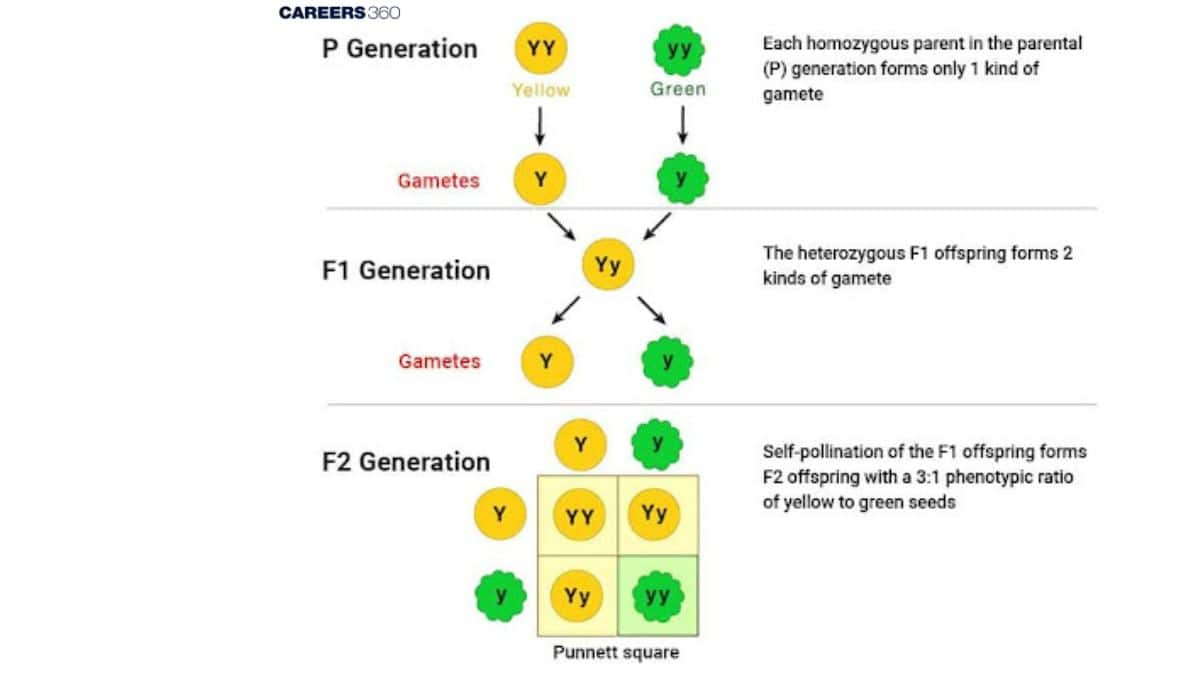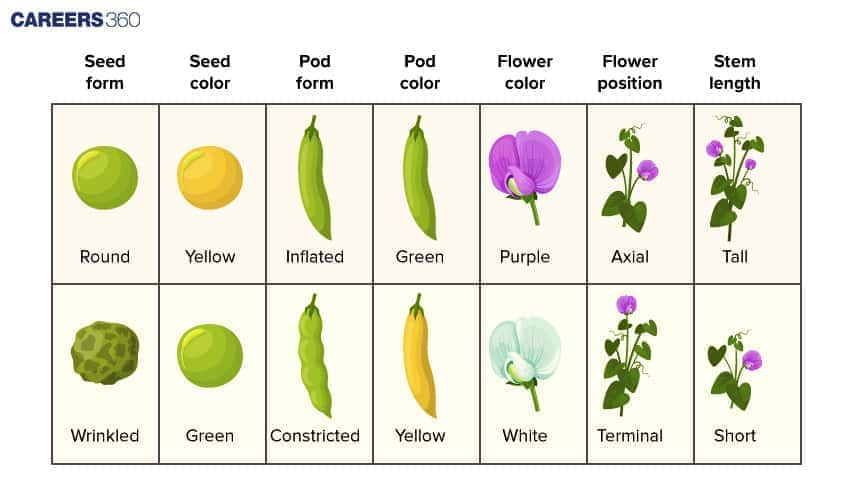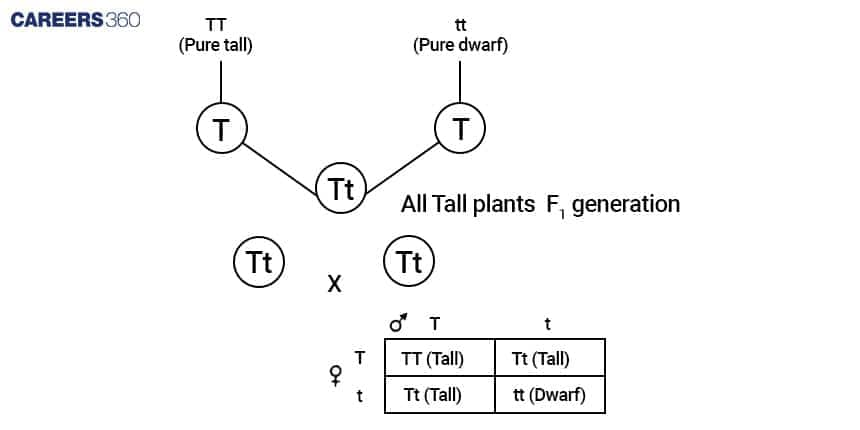Monohybrid Cross - Inheritance Of One Gene: Definition & Example
A monohybrid cross is a genetic experiment in which two different alleles for a specific gene in two organisms are crossed. It is mainly related to the inheritance of a single trait. This type of cross helps in understanding how one gene is inherited, following the laws of inheritance. Through the monohybrid cross, Mendel discovered the Law of Dominance and the Law of Segregation, which are part of the Three Laws of Inheritance.
This Story also Contains
- What is a Monohybrid Cross?
- Mendel's Laws Of Inheritance
- How to Carry Out a Monohybrid Cross?
- Monohybrid Cross Example
- Monohybrid Cross: Genotype And Phenotype Determination
- Video Recommended On Monohybrid Cross - Inheritance Of One Gene
- MCQs on Monohybrid Cross

In Biology, the Monohybrid cross definition includes the study of only one characteristic, such as seed color or shape, throughout generations. In monohybrid inheritance, one allele is often dominant, which masks the expression of the other recessive allele. This is an important topic from the chapter Principles of Inheritance and Variation.
What is a Monohybrid Cross?
A monohybrid cross is a type of genetic breeding experiment that studies the inheritance of a single trait, which is controlled by a single gene locus. This helps in identifying the segregating and recombining nature of alleles in offspring, and this provides fundamental insights into the genetic inheritance pattern, forming the core of modern genetics.
Gregor Mendel, the father of genetics, laid down the foundation of the genetic principles of heredity by systematically experimenting with pea plants in the mid-19th century. He conducted monohybrid crosses very carefully and observed traits such as seed shape, flower colour, and plant height over several generations.
Mendel's approach was systematic and meticulous, focusing on one trait at a time. He used plants that were breeding true for specific traits, meaning plants that consistently passed on the same trait to their offspring when self-pollinated. For example, he crossed tall plants with short ones to study the inheritance of plant height, ensuring accurate results.
For example, Mendel's genetics is one characteristic such as colour and seed shape in pea plants with Mendel's monohybrid cross. Through this method, he could see how individuals might express monohybrid inheritance and the law of dominance and recessiveness of an allele.
Mendel's Laws Of Inheritance
Mendel formulated three basic laws of inheritance based on his experiments on pea plants:
The first is the Law of Dominance, which says one trait can dominate over the other.
The second is the Law of Segregation, where alleles separate randomly during gamete formation.
The third is the Law of Independent Assortment, where alleles of different genes separate independently.
These laws are explained through monohybrid crosses (for dominance and segregation) and dihybrid crosses (for independent assortment). They help to predict the traits and genes in the offspring.
How to Carry Out a Monohybrid Cross?
A monohybrid cross would require the steps that fully explain how traits are passed down from one generation to the next. The following are the steps for carrying out a monohybrid cross. Steps for Carrying Out a Monohybrid Cross:
Identification Of Parental Traits
Select organisms that differ only in one characteristic of interest, such as the color of the flower in plants or the color of fur in animals. For example, can select pea plants with yellow and green colored seeds. YY for yellow, yy for green.
Determine Parents' Genotype
Firstly, research data on the genetic content of organisms chosen for the experiment. See if they are homozygous, with the same alleles, say YY or yy for the trait, or heterozygous, having different alleles, for instance, Yy.
Perform The Cross
Cross a homozygous dominant (YY) with a homozygous recessive (yy) parent, or cross two heterozygous parents (Yy) with one another to view both the dominant and recessive alleles in the offspring.
View Offspring in F1 Generation
Allow the parents to undergo natural self-pollination or mating, depending on the organism. Collect the seeds or offspring from the cross for genetic analysis.
Genotype And Phenotype Ratios
Use Punnett squares or probability to predict the genotype ratio and phenotype ratio among offspring. A Punnett square is a method of showing all of the possible combinations of alleles that each parent can contribute, along with the probabilities.
Offspring Phenotype Analysis
Observe the phenotypes of the offspring for different traits they express. Record the number of offspring that have the dominant and recessive traits.
Interpret Results
Compare observed ratios of phenotypes to the predicted ratios in the Punnett square. Compare whether the traits are according to Mendelian inheritance (e.g., a 3:1 ratio of dominant to recessive traits in the F1 generation). 
Monohybrid Cross Example
A monohybrid cross is a genetic experiment that studies how one trait is inherited from parents. Mendel’s pea plant experiments are the best example of this. It helps explain dominant and recessive traits in plants and humans, like in Huntington’s disease. Example of a monohybrid cross is explained below:
Gregor Mendel’s Peas
Gregor Mendel, in the mid-19th century, did scientific experiments about pea plants that eventually proved to be the very foundation of our present understanding of monohybrid crosses and genetic inheritance. Mendel followed the inheritance of individual traits, such as seed colour and seed texture, through generations and presented principles of Mendel’s Law of Inheritance in a very rational and systematic way.
One of the most renowned experiments done by Mendel was related to studying seed color in peas. Mendel carried out controlled breeding experiments in plants with homozygous yellow seeds (YY), crossing those with plants with homozygous green seeds (yy). All of the first generation, F1, ended up having offspring that produced yellow seeds. Hence, it looked like the yellow allele dominated over the green allele and also managed to do a great masking job over it.
In successive crosses, Mendel crossed the heterozygous yellow-seeded plants of the F1 generation among themselves. The offspring, or the F2 generation of plants, was three yellow-seeded to one green-seeded, in the ratio of 3:1, that is, YY or Yy and yy, respectively. This 3:1 ratio thus cleared Mendel's hypothesis regarding the inheritance of flower color and proved the existence of a dominant and recessive allele.
This experiment is a classic monohybrid cross example that explains monohybrid inheritance. Mendel's controlled breeding established the predictable pattern that one gene follows in terms of its inheritance, such that the dominant allele masks the presence of the recessive allele. The principle is widely applied in the explanation of the outcome of a monohybrid cross in biology, and tools like the Punnett square explain it.
The diagram given below shows the different characteristics of peas used by Mendel in his experiments

Huntington's Disease
Huntington's disease is a case of monohybrid inheritance occurring in humans, and that example is used to describe the interaction between dominant and recessive alleles. It is caused by a mutation in the HTT gene on chromosome 4. The child has a 50% chance of having the disease if one of the parents contributes a single copy of the mutated gene (Hh). Inheritance of two copies, HH causes a more severe illness, while the normal gene, hh does not result in Huntington's disease at all.
The fact that it is dominant means a single copy of the mutated gene is enough to cause the disease, thus allowing monohybrid crosses to predict the probability of inheritance. This purely human genetic disorder, therefore, stresses the need to understand the genetic risk factor and the associated ethics relevant to the genetic counselling and testing of a hereditary disease.
Monohybrid Cross: Genotype And Phenotype Determination
A monohybrid cross helps in studying how a single trait is inherited from parents to offspring. It shows the relationship between an organism’s genotype (genetic makeup) and phenotype (physical trait). This method helps predict the possible traits and gene combinations in the next generation.
Genotype refers to the genetic makeup of an organism, like AA, Aa, or aa.
Phenotype refers to the observable traits, such as tall or short. Homozygous means having two identical alleles, e.g., AA or aa.
Heterozygous means having two different alleles, e.g., Aa.
A monohybrid cross helps determine genotype and phenotype ratios.
For example, crossing two heterozygous tall plants (Tt x Tt) results in:
Genotypic ratio: 1 TT : 2 Tt : 1 tt
Phenotypic ratio: 3 Tall : 1 Short

Video Recommended On Monohybrid Cross - Inheritance Of One Gene
MCQs on Monohybrid Cross
Question: A tall true breeding garden pea plant is crossed with a dwarf true breeding garden pea plant. When the F1 plants were selfed the resulting genotypes were in the ratio of:
1 : 2 : 1 :: Tall homozygous : Tall heterozygous : Dwarf
1 : 2 : 1 :: Tall heterozygous : Tall homozygous : Dwarf
3: 1 Tall: Dwarf
3 : 1:: Dwarf: Tall
Answer: As we learnt in
The conclusion from Punnett Square -
All F1 are tall and in F2 3/4th of the plants are tall.
Thus, phenotypic ratio of 3/4th tall: (1/4TT + 1/2Tt) and 1/4th tt, i.e 3:1 ratio but genotypic ratio of 1:2:1
Hence, the correct option is 1) 1 : 2 : 1 :: Tall homozygous : Tall heterozygous : Dwarf
Question: A cross between two tall plants resulted in offspring having few dwarf plants. What would be the genotypes of both the parents?
TT and Tt
Tt and Tt
TT and TT
Tt and tt
Answer: In this case, the offspring can be either TT (tall), Tt (tall), or Tt (dwarf). Thus, there is a mix of tall and dwarf plants, and most of the plants are tall. Option (1) will give all tall offspring (TT), option (3) also gives only tall plants, and option (4) has a dwarf parent that cannot give any tall offspring.
Hence, the correct answer is Option (2) Tt and Tt.
Question: The production of gametes by the parents, the formation of zygotes, the F1 and F2 plants, can be understood from a diagram is called:
Bullet square
Punch square
Punnett square
Net square
Answer: The Punnett square is a diagrammatic tool used to predict the genotypes of offspring resulting from a particular genetic cross or breeding experiment. It was developed by Reginald C. Punnett in 1905. The square helps biologists determine the probability of an offspring inheriting specific genotypes by organizing the potential genetic contributions from both parents. Each parent’s alleles are represented along the top and side of the square, and the possible combinations of alleles are filled in the grid to show all potential genotypes for the offspring. This tool is especially useful in Mendelian genetics to understand inheritance patterns.
Hence, the correct answer is option 3) Punnett square.
Also Read:
Frequently Asked Questions (FAQs)
Monohybrid crosses do not consider interactions of genes, epistasis or the effects of multiple genes on one characteristic called polygenic inheritance. The crosses also take an independent assortment of alleles, which in most cases of genetic inheritance is not valid either.
A monohybrid cross refers to genetic experimentation on the inheritance of a single trait, controlled by one gene locus. It explains how alleles are segregated and combined in the offspring, therefore giving essential views about the basis of genetic inheritance patterns so important for modern genetics.
In a monohybrid cross, two organisms differing by a single trait—that is, one being homozygous dominant and the other homozygous recessive—are crossed. Then, the offspring are examined to predict genotype and phenotype ratios through the use of tools such as Punnett squares.
Different conclusions, which relate to phenotypic ratios of a monohybrid cross, generally come up with 3:1 in the first generation, indicating the dominance of one allele over its recessive allele. There will be different genotypic ratios depending on whether the alleles are homozygous dominant, heterozygous, or homozygous recessive.